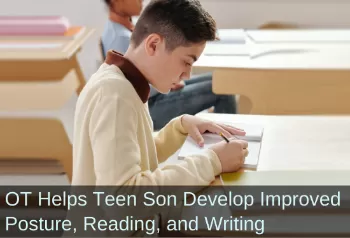Primitive Reflex Integration Case Studies
Young Teen Finds Neuro-Movements Effective; Is Doing Them on His Own Now
Help for posture, fine-motor skills, reading, and pain when writing
After two weeks of rhythmic movements and primitive reflex integration, this mom saw improvements in her son's posture. After a month, his writing was more legible, his reading had improved, and he was no longer experiencing hand pain when writing.
Submitted by Arthi Gavatre, OTR/L

| Before | After |
|---|---|
| Unable to maintain erect posture while sitting | No longer requires excessive verbal and tactile cues to correct posture |
| Continuously shook one or the other leg | Leg shaking is reduced |
| Illegible writing | Writing is more legible |
| Reading difficulty | Reading is improved |
| Experienced hand pain when writing, even after just 3-4 lines | No longer experiencing pain when writing |
My 13 year-old-son had been unable to maintain erect posture while sitting. He also had an urge to continuously shake one or the other leg. Slow, illegible writing and reading difficulty were also issues.
The first thing I introduced to him were the rhythmic movements [from the Brain and Sensory Foundations® course]. He was amused about what I was doing. I then explained to him the rationale behind the movements. When asked if he would like to improve his reading and writing skills, he agreed.
Slowly I introduced the TLR [Tonic Labyrinthine Reflex], ATNR [Asymmetrical Tonic Neck Reflex], and STNR [Symmetrical Tonic Neck Reflex] isometric and integration activities [from the Brain and Sensory Foundations® course]. TLR checking revealed that he was unable to maintain his balance and was swaying. While eliciting ATNR, I found that his trunk moved with the head movement. The STNR checking showed that he had weak proximal muscles, because he had hyperextended elbows. I was able to do the activities once a day.
In the matter of two weeks I could see the difference in my son's sitting posture. Before the reflex integration, I had to give him maximum verbal and tactile cues to correct his posture. But now he was able to sit erect with minimal verbal and tactile cues. His leg shake had also reduced.
By the end of a month, I could see his writing had become more legible, there was also an improvement in his reading ability. At this point I also introduced the hands reflex integration.
His intrinsic muscles were very weak. There was further change with the introduction of hand reflex activities. Now he did not complain of pain in his hands after writing, which he used to even after writing just 3-4 lines.
Six months on and he is doing a lot of activities on his own. He is interested in doing them because he finds them effective.
*Disclaimer: The activities in the Brain and Sensory Foundations curriculum make use of the natural processes of neuroplasticity and development that are innately wired in the design of human beings to promote maturity and function. These activities appear to calm, organize, and mature the neuro-sensory-motor systems just as we see in the healthy development of human infants. Individual results may vary, and we do not claim to offer a diagnosis or cure for any specific condition or disorder. The Brain and Sensory Foundations activities appear to improve overall functioning resulting in measurable improvements for a range of conditions as demonstrated in over 1800 case studies from participants.

